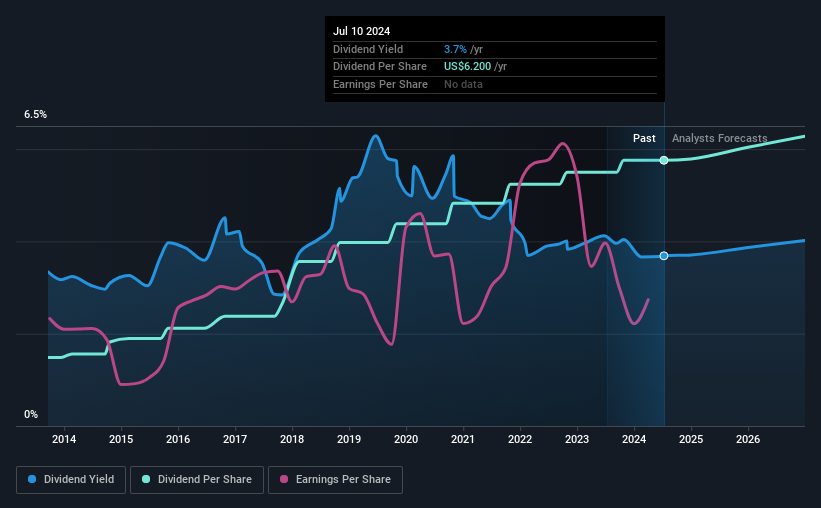Dividend Investors: Don't Be Too Quick To Buy AbbVie Inc. (NYSE:ABBV) For Its Upcoming Dividend
Regular readers will know that we love our dividends at Simply Wall St, which is why it's exciting to see AbbVie Inc. (NYSE:ABBV) is about to trade ex-dividend in the next 3 days. The ex-dividend date is usually set to be one business day before the record date which is the cut-off date on which you must be present on the company's books as a shareholder in order to receive the dividend. The ex-dividend date is an important date to be aware of as any purchase of the stock made on or after this date might mean a late settlement that doesn't show on the record date. Therefore, if you purchase AbbVie's shares on or after the 15th of July, you won't be eligible to receive the dividend, when it is paid on the 15th of August.
The company's next dividend payment will be US$1.55 per share, and in the last 12 months, the company paid a total of US$6.20 per share. Based on the last year's worth of payments, AbbVie has a trailing yield of 3.7% on the current stock price of US$168.14. If you buy this business for its dividend, you should have an idea of whether AbbVie's dividend is reliable and sustainable. So we need to check whether the dividend payments are covered, and if earnings are growing.
Check out our latest analysis for AbbVie
Dividends are typically paid out of company income, so if a company pays out more than it earned, its dividend is usually at a higher risk of being cut. AbbVie paid out 180% of profit in the past year, which we think is typically not sustainable unless there are mitigating characteristics such as unusually strong cash flow or a large cash balance. That said, even highly profitable companies sometimes might not generate enough cash to pay the dividend, which is why we should always check if the dividend is covered by cash flow. Thankfully its dividend payments took up just 49% of the free cash flow it generated, which is a comfortable payout ratio.
It's disappointing to see that the dividend was not covered by profits, but cash is more important from a dividend sustainability perspective, and AbbVie fortunately did generate enough cash to fund its dividend. Still, if the company repeatedly paid a dividend greater than its profits, we'd be concerned. Extraordinarily few companies are capable of persistently paying a dividend that is greater than their profits.
Click here to see the company's payout ratio, plus analyst estimates of its future dividends.
Have Earnings And Dividends Been Growing?
Companies that aren't growing their earnings can still be valuable, but it is even more important to assess the sustainability of the dividend if it looks like the company will struggle to grow. If earnings decline and the company is forced to cut its dividend, investors could watch the value of their investment go up in smoke. With that in mind, we're not enthused to see that AbbVie's earnings per share have remained effectively flat over the past five years. It's better than seeing them drop, certainly, but over the long term, all of the best dividend stocks are able to meaningfully grow their earnings per share.
Another key way to measure a company's dividend prospects is by measuring its historical rate of dividend growth. In the last 10 years, AbbVie has lifted its dividend by approximately 15% a year on average.
The Bottom Line
Has AbbVie got what it takes to maintain its dividend payments? Earnings per share have been effectively flat, which is a bit of a concern given the company is paying out 180% of its profit as dividends, which we feel is uncomfortably high. It's not the most attractive proposition from a dividend perspective, and we'd probably give this one a miss for now.
Although, if you're still interested in AbbVie and want to know more, you'll find it very useful to know what risks this stock faces. For example, we've found 3 warning signs for AbbVie that we recommend you consider before investing in the business.
Generally, we wouldn't recommend just buying the first dividend stock you see. Here's a curated list of interesting stocks that are strong dividend payers.
Have feedback on this article? Concerned about the content? Get in touch with us directly. Alternatively, email editorial-team (at) simplywallst.com.
This article by Simply Wall St is general in nature. We provide commentary based on historical data and analyst forecasts only using an unbiased methodology and our articles are not intended to be financial advice. It does not constitute a recommendation to buy or sell any stock, and does not take account of your objectives, or your financial situation. We aim to bring you long-term focused analysis driven by fundamental data. Note that our analysis may not factor in the latest price-sensitive company announcements or qualitative material. Simply Wall St has no position in any stocks mentioned.
Have feedback on this article? Concerned about the content? Get in touch with us directly. Alternatively, email editorial-team@simplywallst.com

 Yahoo Finance
Yahoo Finance 
